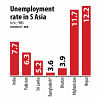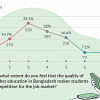High growth, fewer jobs

Bangladesh’s tremendous economic growth has been unable to create jobs proportionately over the past decade, raising questions about the significance of the growth for a large section of the population.
Besides, female participation in the labour force shrank in the last nine years, especially in rural areas, according to a government study on employment, productivity and sectoral investment in Bangladesh.
Employment elasticity, which indicates the ability of an economy to generate employment opportunities for its population as percent of its growth process, declined between fiscal 2005-06 and 2017-18, when the economy was apparently on tremendous growth momentum.
Between fiscal 2005-06 and 2009-10, the country’s employment elasticity was 0.55. It plunged to 0.25 between fiscal 2010-11 and 2017-18, when the economy averaged 6.6 percent GDP growth.
Employment elasticity is a measure of the percentage change in employment associated with a 1 percentage point change in economic growth.
For example, employment elasticity of 0.01 implies that with every 1 percentage point growth in GDP, employment increased by just one basis point (one basis point is one-hundredth of a percentage point).
“In case of agriculture, manufacturing, construction and services sector, the employment elasticity is lower than 1, indicating that employment generation is not very sensitive to growth,” said the study conducted by the General Economics Division under the planning ministry between May and June this year.
The major objective of the study, the first of its kind in the country, was to gain insight into the nexus of economic growth, employment generation, productivity and investment.
The services sector is the only sector that saw an increase in employment elasticity: from 0.27 in fiscal 2009-10 to 0.40 in fiscal 2017-18.
In case of agriculture, it sank to -0.09 between fiscal 2010-11 and 2017-18 from 0.71 between fiscal 2005-06 and 2009-10.
Employment elasticity decreased in the construction sector too -- from 2.22 in fiscal 2009-10 to 0.55 in fiscal 2017-18 -- at a time when the government is implementing a host of mega projects, and there is a construction boom in the country.
Government spending has increased in the construction sector but the expenditure is for big projects like Dhaka Metro Rail and Padma bridge, which are capital intensive in nature, mentioned the study.
“Therefore, the construction sector has failed to generate enough employment in spite of increased public spending,” it added.
Also in the manufacturing sector, employment elasticity came down to 0.65 in fiscal 2017-18 from 0.87 in fiscal 2009-2010.
The study attributed the decline to two simultaneous phenomena: the structural transformation in the economy from agriculture to industrial sector, and industrial sector being more capital intensive.
The garment and textile industries account for a major chunk of the country’s manufacturing sector, and both are becoming more capital intensive rather than labour intensive.
“The non-garment part of the manufacturing sector has remained static,” the study mentioned.
Talking to The Daily Star, Zahid Hussain, former lead economist at the World Bank’s Dhaka office, said, “Overall employment elasticity declined because the decrease in employment elasticity in agriculture and industry far outweighed the increase in employment elasticity in services.”
Employment elasticity in agriculture turned negative as the demand for farm labour dropped with rapidly growing mechanisation of agricultural production processes, he pointed out.
The other reasons include an increased use of high-yielding non-labour inputs and decreased preference for farm work, Zahid mentioned.
“The decline in overall employment elasticity from 0.55 during 2005-10 to 0.25 during 2010-18 reflects to a significant extent the movement of people from agriculture to services.
“Despite sustained expansion in agricultural activities, employment in agriculture declined from 26.2 million in 2010 to 25 million in 2018 while employment in services increased from 19.8 million to 23.8 million respectively. This is why employment elasticity in agriculture has declined from 0.71 to -0.09 while it increased from 0.27 to 0.4 in services.
“Employment in industry increased from 12.1 million in 2010 to 13.1 million in 2018 -- just by one million in eight years -- despite acceleration of industrial growth from 8 percent on average during 2005-10 to 9.6 percent during 2010-18.
“Despite rising growth in industrial output, growth of labour demand in industry was weak because of low investment growth, higher capital intensity of industrial production processes and the spread of automation.
In recent years, industrial growth came more from capital intensive manufacturing and construction sectors that are domestic market-oriented, rather than the labour intensive export-oriented sectors, he pointed out.
According to Zahid, a big setback in the growth process has been the loss of female participation in employment. By all metrics, their contribution to the economy was lower in 2018 than in 2010.
“Weak growth of labour demand affected females more than males. Instead of continuing to actively seek employment, discouraged female labour appears to have opted out of the labour market …,” he noted.
The number of unemployed females increased to 1.2 million in 2018 from 1 million in 2010, while the number of females in employment dropped to 16 million last year from 16.2 million in 2010.
In rural areas, 12.6 million females were employed in 2010. The number fell to 11.6 million in 2018.
The study suggested a proper employment strategy for promoting female participation in the labour force.
“Opportunities need to be opened up and the barriers to female labour force participation need to be eliminated.” Women are often subjected to violence, and laws regarding this need to be made more stringent, it noted.
Infrastructure such as childcare facilities at workplaces, increase in access to education and training, availability of maternity leave and growth of industries where large number of women are involved will help matters, it pointed out.
Better implementation of laws is necessary to provide an enabling working environment for women. “This will also ensure better wages and also the status of women at the workplace.”
It also suggested conducive monetary and fiscal policies for improving employment elasticity and steps to help the sectors overcome the financing and unskilled labour problems.
Automation or advanced technology may displace some workers but this will be compensated by jobs created elsewhere in the economy.
“However, since further advancement of technology will require high-skilled labour, focusing on demand-driven skill development system should be the priority for Bangladesh,” it added.

 For all latest news, follow The Daily Star's Google News channel.
For all latest news, follow The Daily Star's Google News channel. 








Comments